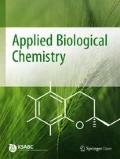Abstract
The inhibitory effects of components derived from Cinnamomum cassia leaf on nitric oxide (NO) production in RAW 264.7 cells and on expression of inducible NO synthase (iNOS) were determined and compared to those of three commercially available components. Spectral analysis characterized the active constituent of this C. cassia extract as cinnamyl alcohol. The inhibitory effects varied with both chemical and concentration used. Cinnamyl alcohol showed inhibitory effects on NO production of 62.5%, 41.8%, and 22.1% at 1.0, 0.5, and 0.1 μg/μL, respectively. However, little or no inhibitory effect was observed for cedrene, cinnamic acid, copaene, eugenol, and limonene. Suppression effects of cinnamyl alcohol on iNOS expression were revealed by Western blot analysis. As a naturally occurring therapeutic agent, cinnamyl alcohol could be useful for developing new types of NO inhibitors.
We’re sorry, something doesn't seem to be working properly.
Please try refreshing the page. If that doesn't work, please contact support so we can address the problem.
Abbreviations
- IFN-γ:
-
interferon-γ
- iNOS:
-
inducible nitric oxide synthase
- LPS:
-
lipopoly saccharide
- NO:
-
nitric oxide
References
Billiar TB, Curran RD, Stuehr DJ, West MA, Bentz BG, and Simmons RL (1989) An L-arginine-dependent mechanism mediates Kupffer cell inhibition of hepatocyte protein synthesis in vivo. J Exp Med 169, 1467–1472.
Bradford MM (1976) A rapid sensitive method for the quantitation of microgram quantities of protein utilizing the principle of protein-dye binding. Anal Biochem 72, 248–254.
Chopra RN, Nayer SL, and Chopra IC (1980) In Glossary of Indian Medicinal Plants. pp. 51–55. Council of Scientific and Industrial Research, New Delhi, India.
Colegte SM and Molyneux RJ (1993) In Bioactive Natural Products: Detection, Isolation and Structure Determination. CRC Press, Boca Raton, FL, U.S.A.
Doyle MP and Hockstra JW (1981) Oxidation of nitrogen oxides by bound dioxygen in hemoproteins. J Inorg Chem 14, 351–358.
Forstermann U, Schmidt HHHW, Pollack JS, Sheng H, Mitchell JA, Warner TD, Nakane M, and Murad F (1991) Isoforms of nitric oxide synthase. Biochem Pharmacol 42, 1849–1857.
Kim HK, Kim JR, and Ahn YJ (2004) Acaricidal activity of cinnamaldehyde and its congeners against Tyrophagus putrescentiae (Acari: Acaridae). J Stored Prod Res 40, 55–63.
Kirikae T, Kirikae F, Oghiso Y, and Nakano M (1996) Microtubule-disrupting agents inhibit nitric oxide production in murine peritoneal macrophages stimulated with lipopolysaccharide or paclitaxel (Taxol). Infect Immun 64, 3379–3384.
Lee HS (2007) Anticoagulant properties of the active compound derived from Cinnamomum cassia Bark. Food Sci Biotechnol 16, 218–222.
Lee HS and Ahn YJ (1998) Growth-inhibiting effects of Cinnamomum cassia bark-derived materials on human intestinal bacteria. J Agric Food Chem 46, 8–12.
Lee HS, Kim BS, and Kim MK (2002) Suppression effect of Cinnamomum cassia bark-derived component on nitric oxide synthase. J Agric Food Chem 50, 7700–7703.
Lee HS, Lee CH, Kim SY, and Ahn YJ (2004) Cytotoxic and mutagenic effects of Cinnamomum cassia bark-derived materials.J. Microbiol. Biotechnol. 14, 1176–1181.
Lee HS, Lee SH, Kim YS, Song CG, and Kim MK (2000) Effect of oriental medicinal plants on nitric oxide synthase activity. Food Sci Biotechnol 9, 77–82.
Lohinai Z, Benedek P, Feher E, Gyorfi A, Rosivall L, Fazekas A, Salzman AL, and Szabo C (1998) Protective effects of mercaptoethylguanidine, a selective inhibitor of inducible nitric oxide synthase, in ligature-induced periodontitis in the rat. British J Pharm 123, 353–360.
Marletta MA (1993) Nitric oxide synthase structure and mechanism. J Biol Chem 268, 12231–12234.
Moncada S, Palmer RMJ, and Higgs EA (1991) Nitric oxide: physiology, pathophysiology and pharmacology. Pharmacol Rev 43, 109–141.
Namba T (1986) In Coloured illustrations of wakan-yaku: the crude drugs in Japan, China and the neighbouring countries. Hoikusha Publishing, Osaka, Japan.
Philip KM and Philip AB (1996) 7-Nitroindazole: an inhibitor of nitric oxide synthase. Method Enzymol 268, 393–398.
Salgo MG, Stone K, Squadrito GL, Battista JR, and Pryor WA (1995) Peroxynitrite causes apoptosis in rat thymocytes. Biochem Bioph Res Co 210, 1025–1030.
Sánchez-Ramos I and Castaňera P (2001) Acaricidal activity of natural monoterpenes on Tyrophagus putrescentiae (Schrank), a mite of stored food. J Stored Prod Res 37, 93–101.
Schmidt HHW, Lohmann SM, and Walter U (1993) The nitric oxide and cGMP signal transduction system: regulation and mechanism of action. Biochem Biophys Acta 1178, 153–175.
Schneemann M, Schoedon G, Frei K, and Schaffner A (1993) Immunovascular communication: activation and deactivation of murine endothelial cell nitric oxide synthase by cytokines. Immunol Lett 35, 159–162.
Takehara Y, Nakahara H, Okada S, Yamaoka K, Hamazaki K, Yamazato A, Inoue M, and Utsumi K (1999) Oxygen concentration regulates NO-dependent relaxation of aortic smooth muscles. Free Radic Res 30, 287–294.
Vizi ES (2001) Nitric oxide in neurotransmission. Trends Pharmacol Sci 22, 595.
Author information
Authors and Affiliations
Rights and permissions
About this article
Cite this article
Lee, HS. Chemical composition of Cinnamomum cassia leaf oils and suppression effect of cinnamyl alcohol on nitric oxide synthase. J. Korean Soc. Appl. Biol. Chem. 52, 480–485 (2009). https://doi.org/10.3839/jksabc.2009.082
Received:
Accepted:
Issue Date:
DOI: https://doi.org/10.3839/jksabc.2009.082

